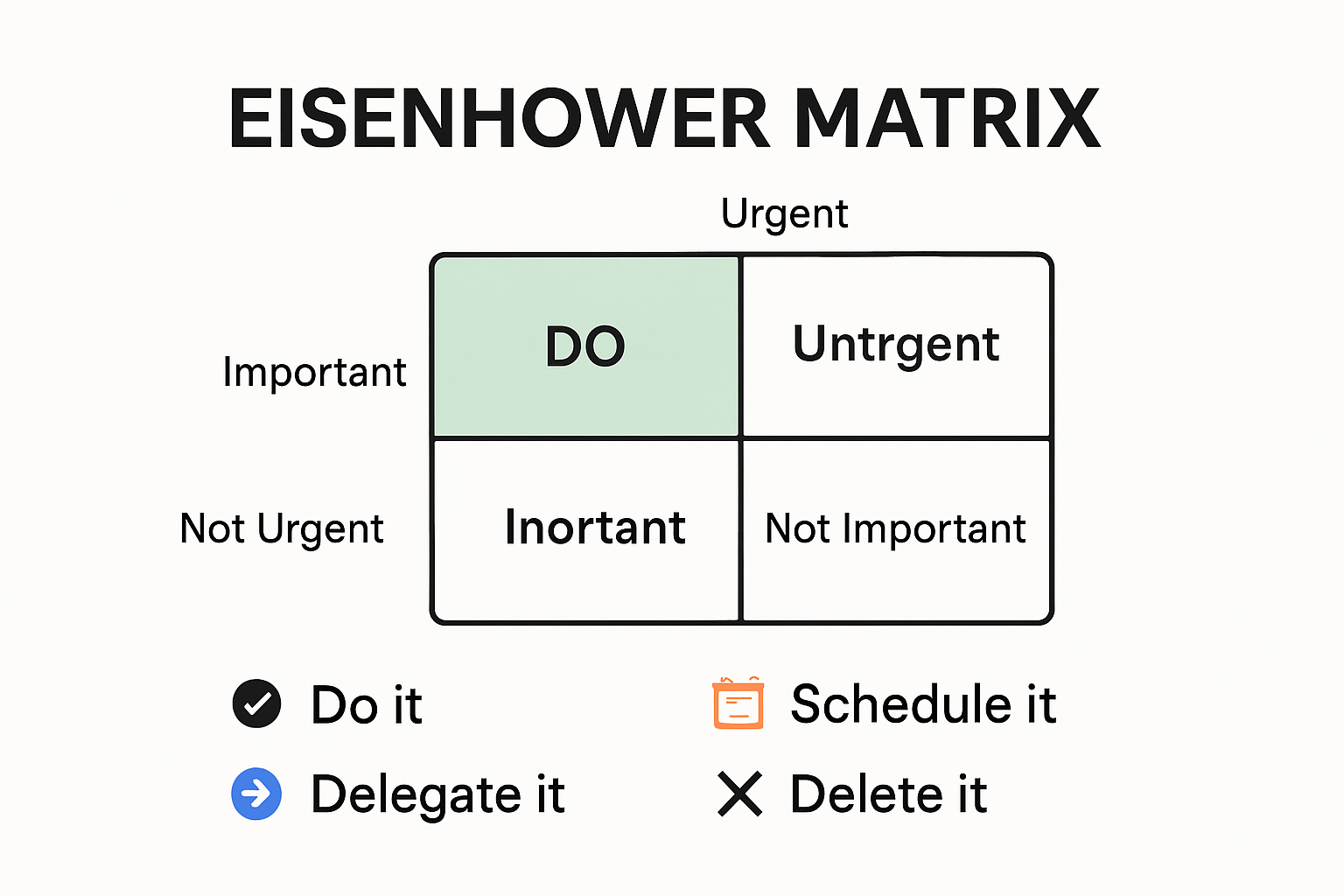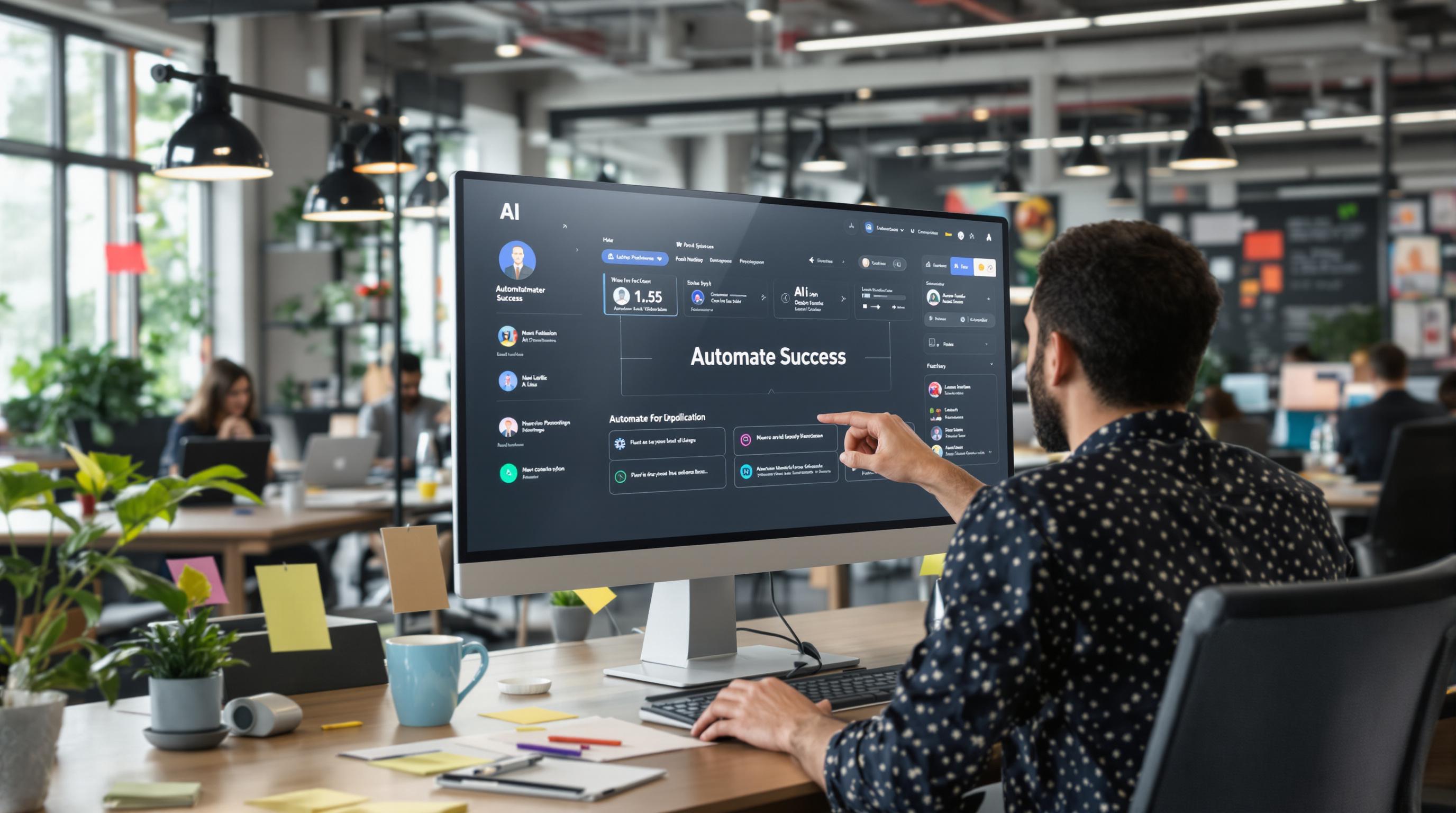Managers in 2025 are working more hours than ever yet still feel like there is never enough time in the day. Even with endless productivity apps and automation tools available, more than 84 percent of complex administrative work can now be automated according to recent research. That sounds like managers should be drowning in free time by now but the reality is most are stuck playing catch-up. So the real secret is not about squeezing more into your schedule with new tech. It is learning which old habits to drop, which tools to trust, and how tiny shifts can free up hours every single week starting now.
Table of Contents
- Smart scheduling strategies for busy managers
- Leveraging technology to automate daily tasks
- Effective delegation and team management tips
- Real-world productivity hacks from industry leaders
Quick Summary
| Takeaway | Explanation |
|---|---|
| Prioritize tasks using the Eisenhower Matrix | Categorize tasks by urgency and importance to enhance focus and efficiency. |
| Utilize strategic time-blocking | Allocate specific times for focused tasks to improve productivity and minimize distractions. |
| Embrace AI-powered tools for automation | Implement AI assistants and automation to streamline routine tasks and enhance efficiency. |
| Establish clear communication in delegation | Communicate expectations and outcomes clearly to empower team members and ensure comprehension. |
| Adopt a holistic approach to productivity | Balance technological tools and human creativity for effective and meaningful workplace productivity. |
Smart Scheduling Strategies for Busy Managers
Managers face constant time pressure, juggling multiple responsibilities that demand strategic planning and efficient execution. Mastering time management isn’t just about working harder—it’s about working smarter through intelligent scheduling techniques that maximize productivity and minimize unnecessary stress.
Prioritizing Tasks with the Eisenhower Matrix
Successful time management begins with understanding task priorities. The Eisenhower Matrix offers a powerful framework for categorizing tasks based on their urgency and importance. This method divides work into four critical quadrants:
- Urgent and Important: Immediate actions requiring your direct attention
- Important but Not Urgent: Strategic planning and long-term development tasks
- Urgent but Not Important: Potential distractions that can be delegated
- Neither Urgent nor Important: Tasks to eliminate or minimize

By systematically sorting tasks through this lens, managers can focus their energy on high-impact activities that drive meaningful progress. This approach prevents getting trapped in reactive work patterns and ensures consistent advancement of key organizational objectives.
Here is a table summarizing the four quadrants of the Eisenhower Matrix and the recommended action for each:
| Quadrant | Description | Recommended Action |
|---|---|---|
| Urgent & Important | Immediate actions requiring direct attention | Do immediately |
| Important, Not Urgent | Strategic planning and long-term development | Schedule for later |
| Urgent, Not Important | Distractions that can be delegated | Delegate to others |
| Neither Urgent nor Important | Low-value or distracting tasks | Eliminate or minimize |
Strategic Time-Blocking Techniques
Time-blocking represents a game-changing strategy for managers seeking enhanced productivity. According to Forbes research, this technique involves allocating specific time periods in your calendar for distinct types of work. Instead of constantly switching between tasks, you create dedicated blocks for focused work, meetings, emails, and strategic thinking.
Effective time-blocking requires discipline and intentional planning. Start by identifying your most productive hours and scheduling complex, high-concentration tasks during those windows. Communicate these blocks to your team, establishing clear boundaries that protect your concentrated work time while maintaining transparency about availability.
Mastering the Art of Delegation
Delegation is not about offloading work—it’s a strategic approach to team management and personal efficiency. Research indicates that effective delegation allows managers to leverage team skills, distribute workload intelligently, and focus on high-level strategic responsibilities.
Successful delegation involves three critical steps: selecting the right team member, providing clear instructions, and establishing robust follow-up mechanisms. Choose team members whose skills align with specific tasks, articulate expectations precisely, and create checkpoints to monitor progress without micromanaging.
Implementing these smart scheduling strategies transforms how managers approach their workday. By prioritizing tasks systematically, blocking time strategically, and delegating effectively, leaders can reclaim control over their schedules, reduce stress, and drive more meaningful organizational outcomes. Remember, effective time management isn’t about doing more—it’s about doing the right things at the right time with maximum efficiency.
Leveraging Technology to Automate Daily Tasks

In the rapidly evolving digital workplace, managers are increasingly turning to technological solutions to streamline their workflow and reduce administrative burdens. Automation represents a critical strategy for reclaiming valuable time and focusing on high-impact strategic activities.
AI-Powered Personal Assistants
Research from a 2024 productivity study demonstrates the transformative potential of generative AI personal assistants. By deploying advanced AI tools developed on secure platforms like Microsoft Azure, managers can dramatically enhance their productivity. The study revealed remarkable performance improvements ranging from 3.3% to 69% across various tasks, particularly in areas involving complex information summarization and instruction creation.
These AI assistants can handle multiple administrative functions simultaneously. They can draft emails, schedule meetings, create detailed meeting summaries, generate reports, and even provide preliminary research on complex topics. The key advantage lies in their ability to learn and adapt to individual working styles, becoming increasingly efficient over time.
Here is a table summarizing the functions of AI-powered personal assistants and their benefits for managers:
| Function | Benefit |
|---|---|
| Drafting emails | Saves time on communication |
| Scheduling meetings | Reduces scheduling conflicts and manual input |
| Generating meeting summaries | Provides accurate and quick records |
| Creating reports | Streamlines reporting tasks |
| Providing research | Accelerates information gathering |
| Learning user preferences | Improves efficiency over time |
Robotic Process Automation for Routine Tasks
Robotic Process Automation (RPA) represents another powerful technological solution for task automation. A comprehensive research paper explores how RPA tools can capture and emulate user interactions with computer systems, effectively automating routine tasks previously performed manually.
For managers, RPA can be particularly transformative in handling repetitive administrative processes. This might include expense report processing, invoice management, data entry, compliance documentation, and standard communication workflows. By implementing RPA, managers can significantly reduce time spent on mundane tasks and minimize human error.
Government and Enterprise Automation Insights
Groundbreaking research examining government bureaucratic processes provides fascinating insights into automation’s potential. The study revealed that approximately 84% of complex administrative transactions could be automated, potentially saving the equivalent of 1,200 person-years of work annually.
This principle extends beyond government sectors into corporate environments. Managers can apply similar automation strategies to streamline internal processes, reduce operational overhead, and redirect human resources toward more creative and strategic initiatives. The goal isn’t to replace human workers but to augment their capabilities by eliminating repetitive, low-value tasks.
Successful technological automation requires a strategic approach. Managers must carefully assess which tasks are most suitable for automation, ensure robust security protocols, and provide adequate training for team members to effectively utilize these technological tools.
By embracing AI-powered assistants, RPA technologies, and intelligent automation strategies, managers can transform their workflow. The result is a more efficient, responsive, and strategic approach to workplace productivity that leverages cutting-edge technological solutions to drive organizational success.
Effective Delegation and Team Management Tips
Successful managers understand that delegation is more than simply assigning tasks—it’s a strategic approach to team development, productivity, and organizational efficiency. Mastering the art of delegation requires nuanced skills that balance team empowerment with strategic oversight.
Understanding the Fundamentals of Strategic Delegation
Harvard Business School Online provides critical insights into effective delegation, emphasizing that successful task distribution goes far beyond mere task assignment. The key lies in matching tasks to individual team members’ unique strengths, capabilities, and professional development goals.
Effective delegation involves carefully assessing each team member’s skills, potential, and current workload. Managers must develop a deep understanding of their team’s individual capabilities, learning styles, and professional aspirations. This approach transforms delegation from a mechanical task distribution process into a strategic talent development opportunity.
Creating Clear Expectations and Communication Frameworks
Financial Management Magazine highlights the critical importance of establishing clear communication protocols when delegating tasks. Successful delegation requires precise articulation of expectations, including:
- Specific Outcome Objectives: Clearly defined goals and desired results
- Performance Standards: Explicit quality and performance benchmarks
- Resource Allocation: Necessary tools, information, and support mechanisms
- Timeline and Milestones: Specific deadlines and interim check-in points
By creating transparent communication frameworks, managers ensure team members understand not just what needs to be done, but how success will be measured. This clarity reduces ambiguity, minimizes potential misunderstandings, and empowers team members to take ownership of their assigned responsibilities.
Here is a table summarizing key elements for successful delegation and their impact on team performance:
| Delegation Element | Description | Impact on Team |
|---|---|---|
| Specific Outcome Objectives | Clearly defined goals and results | Provides clarity |
| Performance Standards | Explicit quality and performance benchmarks | Sets expectations |
| Resource Allocation | Access to tools and support | Enables task completion |
| Timeline and Milestones | Deadlines and check-in points | Ensures progress tracking |
| Open Communication | Transparent feedback and queries | Builds trust and empowerment |
Developing Delegation as a Leadership Growth Strategy
GovLeaders.org emphasizes delegation as a powerful leadership development tool. Effective delegation isn’t just about task distribution—it’s a strategic approach to building organizational capability and individual professional growth.
Successful managers view delegation as an opportunity to:
- Develop emerging leadership talent
- Build team members’ confidence and skills
- Create scalable and resilient organizational structures
- Reduce personal administrative burden
- Foster a culture of trust and accountability
Implementing a robust delegation strategy requires ongoing commitment. Managers must remain available for guidance, provide constructive feedback, and create safe environments where team members can ask questions and learn from challenges.
The most effective delegation strategies recognize that each task represents an opportunity for professional development. By thoughtfully matching tasks to individual capabilities, establishing clear expectations, and maintaining supportive oversight, managers can transform delegation from a administrative necessity into a powerful leadership tool that drives individual and organizational success.
Real-World Productivity Hacks from Industry Leaders
Industry leaders continuously evolve their approaches to productivity, integrating cutting-edge strategies that go beyond traditional time management techniques. Their insights offer valuable lessons for managers seeking to optimize performance and maintain peak professional effectiveness.
Redefining Productivity in the AI Era
Research from the Financial Times highlights an emerging trend of AI-savvy managers who can effectively integrate technological tools while maintaining critical human connections. The most successful leaders are those who understand how to leverage AI without losing the essential human elements of leadership.
The landscape of productivity is shifting dramatically. Managers must now develop skills that balance technological efficiency with emotional intelligence. This means learning to work alongside AI systems, using them as collaborative tools rather than replacement mechanisms. The key is to focus on tasks that require nuanced human judgment, creativity, and complex problem-solving.
Strategic Slowdown and Deep Work
Cal Newport’s groundbreaking approach to productivity challenges the traditional notion of constant busyness. His “Slow Productivity” concept advocates for a more intentional approach to work, emphasizing quality over quantity. This strategy involves:
- Reducing Task Lists: Focusing on fewer, more impactful projects
- Scheduling Slow Seasons: Creating space for deep, meaningful work
- Implementing No-Meeting Mondays: Protecting focused work time
- Prioritizing Personal Time: Ensuring sustainable performance
This approach recognizes that constant activity doesn’t equate to meaningful productivity. Instead, leaders are encouraged to create space for deep thinking, strategic planning, and meaningful innovation.
AI-Powered Productivity Optimization
Cutting-edge research explores how advanced AI techniques can enhance workplace productivity and employee well-being. The study demonstrates the potential of machine learning and neurobiological data to create more intelligent, adaptive work approaches.
The most forward-thinking managers are now looking at productivity through a holistic lens. This means:
- Integrating AI tools that can predict and prevent burnout
- Using machine learning to optimize individual work patterns
- Creating personalized productivity strategies based on individual neurological and performance data
Successful productivity isn’t about working harder, but working smarter. Industry leaders understand that true effectiveness comes from a combination of technological innovation, strategic thinking, and a deep understanding of human potential.
The most successful managers in 2025 will be those who can seamlessly blend technological tools with human creativity, who understand the value of both intense focus and deliberate rest, and who view productivity as a holistic approach to professional and personal growth. They recognize that productivity is not about filling every moment with activity, but about creating meaningful impact through strategic, intentional work.
Frequently Asked Questions
What is the Eisenhower Matrix and how can it help managers?
The Eisenhower Matrix is a task prioritization tool that categorizes tasks based on urgency and importance. It helps managers focus on high-impact activities by sorting tasks into four quadrants: urgent and important, important but not urgent, urgent but not important, and neither urgent nor important.
How can managers implement effective time-blocking techniques?
Managers can implement time-blocking by scheduling specific periods in their calendars for dedicated work. This method reduces task-switching and allows for focused efforts on high-priority tasks while communicating those time blocks to their teams for clearer availability.
What role do AI-powered personal assistants play in improving productivity?
AI-powered personal assistants can automate administrative tasks like scheduling meetings, drafting emails, and summarizing information. By handling routine responsibilities, they allow managers to focus on strategic initiatives and enhance overall productivity.
How does effective delegation contribute to team management?
Effective delegation empowers team members by matching tasks to their strengths while providing clear expectations and support. This approach not only reduces the manager’s workload but also fosters team development and accountability, leading to higher productivity outcomes.
Transform Busy Workdays Into Productive Wins with Gammatica
Are you ready to stop drowning in administrative tasks and finally put those time-saving hacks for managers into action? If the article highlighted your struggle with never-ending emails, inefficient delegation, and constant context-switching, you are not alone. Managers everywhere want to focus on high-impact work but lose precious hours to organizing, tracking, and repetitive communication. Gammatica takes the stress out of your daily workflow. Automate repetitive steps, delegate with clarity using Kanban boards and smart checklists, and get AI-powered suggestions that match your team’s real needs. Say goodbye to scattered schedules and overwhelming to-do lists.

Take back your time and see for yourself how Gammatica can streamline your day. Explore features like time tracking, seamless calendar integration, and instant meeting tools on our AI project management platform. Free up to sixteen hours a week and build the productive leadership routine you always wanted. Visit Gammatica.com now and experience a smarter, more efficient way to manage your team.



